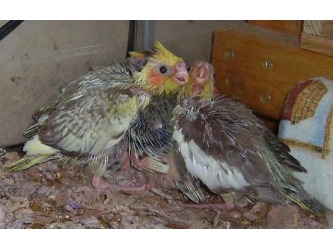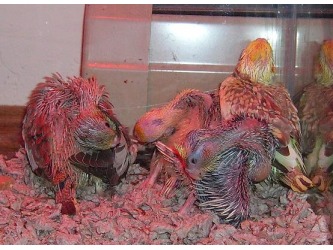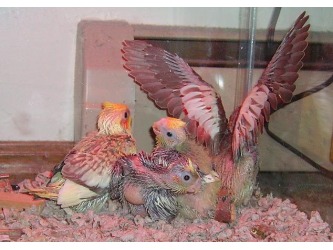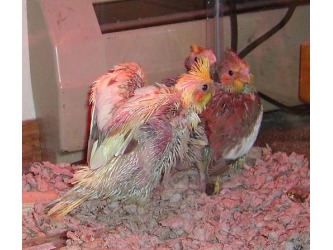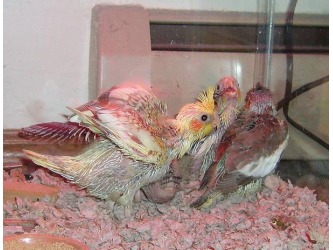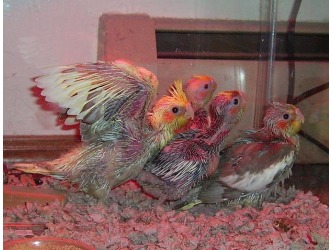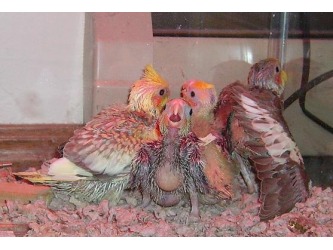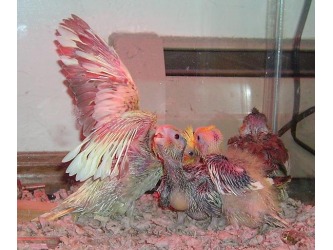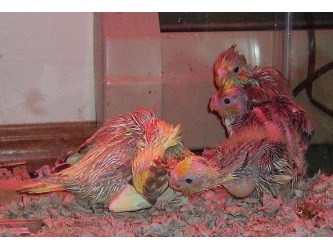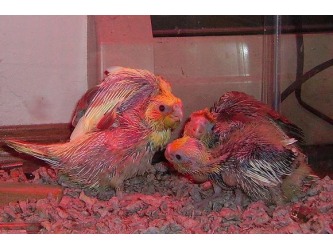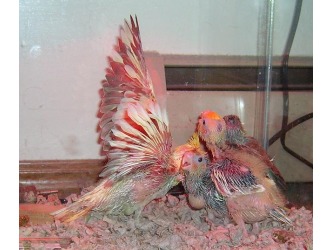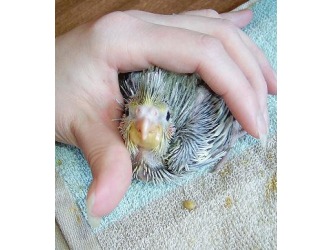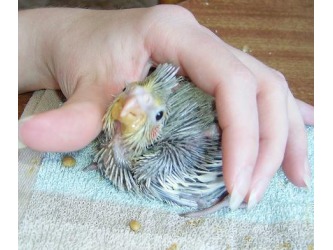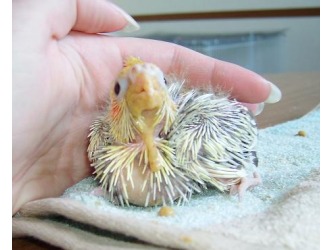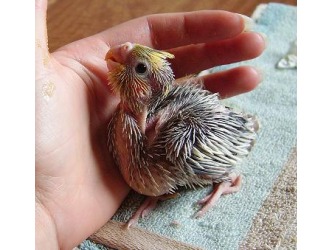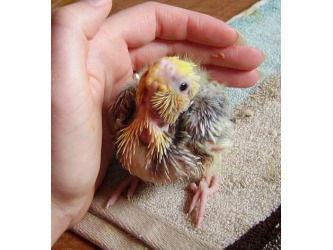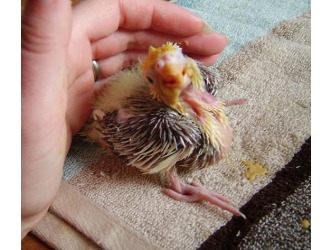The Nursery

I created their cockatiel nursery from: 10 gallon gank with a screen top. I put fleece over the top of the screen to help hold in the heat and cut a hole in the fleece for the red light (25w). Underneath the tank I put a heating pad and placed this all on top of cutting board and risers which help to regulate the heat under the tank. (The heating pad I used is for reptile heating, so the risers allow for air to flow underneath the tank which helps keep the temperature from getting too high and allows for heat adjustment.)
Inside the tank, I placed fleece over the area where the heating pad is and covered the rest with Carefresh bedding. Carefresh is also the material that is in their nesting box, so the smell and feel should be familiar to them. I also added three short dishes. These dishes will later hold water, pellet and seed foods, and a fresh mixture. Since the babies are so far apart in age, the older babies will be needing to perch and exercise before the younger ones are able to be moved to an open cage. Because of this age gap, I also added a perch to one of the corners. I would like to keep the babies together, rather than split them into two pairs when they can all be hand fed, so hopefully I will be able to address everyone's needs in one place!
(P.s this tank gets cleaned at least once a day - especially replacing all of the bedding and washing the half of the tank where the cockatiel babies sleep! This is very important for the health of the babies!!)
4-16-09: After the first two cockatiel chicks were in here for a few hours, I quickly noticed that I had to make a few changes for them. Their parents had stopped staying in the nest to keep them warm when the oldest chick was about 11 days old. Because of this, they were used to keeping each other warm but living in cooler, room temperature conditions. This individual clutch forced me to make some changes: I had to slowly remove the heating pad and put the lamp on the other side of the tank because it was too hot for them! This is unusual though, and my model would have worked well if they were normal chicks!
Babies in the Nursery! (Click an image to see it larger)
Hand Feeding

This is the chart that I will generally follow:
(I say generally because the babies will tell me when they need me to feed them - the crop must be almost completely empty before each feeding or it can cause serious problems)
14-19 days (7-10cc's): 6:00am,10:30am, 3:00pm, 7:30pm, 12:00am
20-30 days (9-12cc's): 7:00am, 12:00pm, 6:00pm, 11:00pm
31-45 days (11-15cc's): 7:00am, 3:00pm, 11:00pm
46-60 days (11-15cc's): 8:00am, 8:00pm
61 days to weaning (11-15cc's): 8:00pm
4-22-10: I have greatly improved my technique since this time, when I took on my little baby lovebird. I have found that a digital thermometer is much more reliable and pipettes and eyedroppers for feeding are much easier to control than syringes. They tend to be even less messy and I highly recommend these changes if you are planning on feeding babies!
To be expected, the babies wanted nothing to do with hand feeding from the start!
I use zupreem formula for the babies, following the directions on the package. (I fed their parents zupreem pellets and they have been feeding them to the babies, so I stayed with the same brand.)
The babies had no idea what was going on and it took a few tries to get them to realize I was trying to give them food. I wasn't able to get them to eat much the first time, but I will plan on feeding them a bit more often (depending on how much they eat each time) until they get the idea.
I ended up using a small syringe to start them off, but may be switching to other tools as soon as they get the hang of this. (I'll add more on this if I do!) As they were not used to being fed this way, it was easier to direct the formula with the syringe to make sure it was going where I wanted it!
4-17-09: I tried using a larger syringe this morning and it worked great! They are finally trusting me and it is much easier to make sure they are eating as much as they are supposed to at each feeding.
4-20-09: After using the larger syringe for a few days, I've actually decided that it is the tool I prefer. I did try using the other tools again, but they seem to be a lot messier! The syringe allows me to control how much and how fast the formula is entering their mouths. It also allows for more accurate measurement so that I can keep a good log of how much they are eating.
Messy faces! (Click an image to see it larger)
The Baby Cage
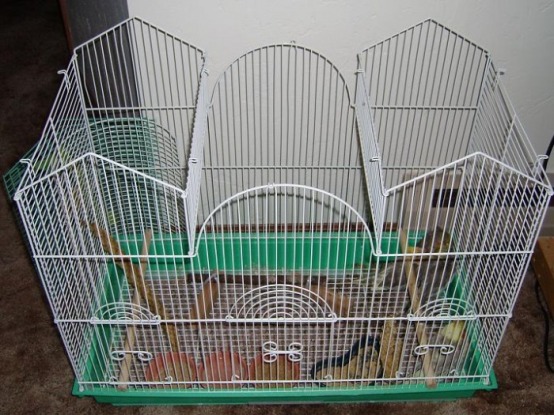
The cockatiel babies were moved into their cage on Day 28. (They had been placed in a smaller cage earlier but needed more room to run around now that they were getting older. Babies can remain in a nursery rather than moving to a smaller transition cage.)
I currently leave the top off the cage for easy access, but this will be replaced when they start climbing. There are lower perches placed inside, low enough for the cockatiel babies to be able to step onto from the bottom of the cage. I also moved the perch from their nursery into this cage.
There are 4 different food dishes in the cage, along with two hanging sprays of millet. The dishes hold water, dry formula mixed with small pellet food, pellet food on it's own, and moist pellets.
I also filled the bottom under the grate with carefresh bedding. This creates a soft landing if their feet fall through and soaks up their waste.

